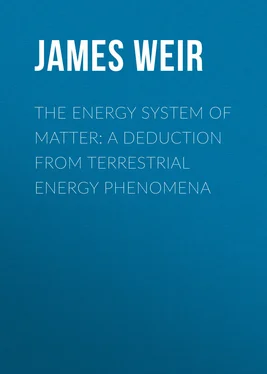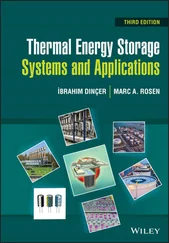James Weir - The Energy System of Matter - A Deduction from Terrestrial Energy Phenomena
Здесь есть возможность читать онлайн «James Weir - The Energy System of Matter - A Deduction from Terrestrial Energy Phenomena» — ознакомительный отрывок электронной книги совершенно бесплатно, а после прочтения отрывка купить полную версию. В некоторых случаях можно слушать аудио, скачать через торрент в формате fb2 и присутствует краткое содержание. Жанр: foreign_antique, Физика, foreign_edu, на английском языке. Описание произведения, (предисловие) а так же отзывы посетителей доступны на портале библиотеки ЛибКат.
- Название:The Energy System of Matter: A Deduction from Terrestrial Energy Phenomena
- Автор:
- Жанр:
- Год:неизвестен
- ISBN:нет данных
- Рейтинг книги:3 / 5. Голосов: 1
-
Избранное:Добавить в избранное
- Отзывы:
-
Ваша оценка:
- 60
- 1
- 2
- 3
- 4
- 5
The Energy System of Matter: A Deduction from Terrestrial Energy Phenomena: краткое содержание, описание и аннотация
Предлагаем к чтению аннотацию, описание, краткое содержание или предисловие (зависит от того, что написал сам автор книги «The Energy System of Matter: A Deduction from Terrestrial Energy Phenomena»). Если вы не нашли необходимую информацию о книге — напишите в комментариях, мы постараемся отыскать её.
The Energy System of Matter: A Deduction from Terrestrial Energy Phenomena — читать онлайн ознакомительный отрывок
Ниже представлен текст книги, разбитый по страницам. Система сохранения места последней прочитанной страницы, позволяет с удобством читать онлайн бесплатно книгу «The Energy System of Matter: A Deduction from Terrestrial Energy Phenomena», без необходимости каждый раз заново искать на чём Вы остановились. Поставьте закладку, и сможете в любой момент перейти на страницу, на которой закончили чтение.
Интервал:
Закладка:
It is easy to conceive, also, that in the course of an energy transformation, the material may attain an energy condition in which the incepting influence no longer affects it. Take once more the case of the iron ball. It is well known that, at a high temperature, iron becomes non-magnetic. It would follow, then, that if the rotational transformation in the magnetic field could be carried out to the requisite degree, so that, by the continuous application of that heat energy which is the final product of the process, the ball had attained this temperature, then the other transformation consequent on the displacement of the ball from the attracting pole could not take place. No change has really occurred in the incepting energy conditions. They are still continuous and persistent, but the energy changes in the material itself have carried it, to a certain degree, beyond the influence of these conditions.
15. Cohesion as an Incepting Influence
Other aspects of incepting energy may be derived from the examples cited above. Returning to the case of the rotating copper sphere, let it be assumed that in consequence of its rotation in the magnetic field it is raised from a low to a high temperature. Due to the heating effect alone, the mass will expand or increase in volume. This increase is the evidence of a definite energy process by which certain particles or portions of the mass have in distortion gained energy of position—energy of separation—or potential energy relative to the centre of the sphere. In fact, if the mass were allowed to cool back to its normal condition, this energy might by a suitable arrangement be made available for some form of external work. It is obvious, however, that this new energy of position or separation which has accrued to the mass in its heated condition has in reality been obtained by the transformation of the "work" energy originally applied. The abnormal displacement of certain particles or portions of the mass from the centre of the sphere is simply the external evidence of their increased energy. Now this displacement, or strain, due to the heat expansion, is carried out against the action of certain cohesive forces or stresses existing between the particles throughout the mass. These cohesive forces are, in fact, the agency which determines this transformation of heat into energy of position. Their existence is essential to the process. But these cohesive forces are simply the external manifestation of that energy by virtue of which the mass tends to maintain its coherent form. They are the symbol of that energy which might be termed the cohesion energy of the mass—they are, in fact, the symbol of the incepting energy influence of the transformation. This incepting energy influence of cohesion is one which holds sway throughout all solid material. It is, therefore, found in action in every movement involving the internal displacement or distortion of matter. It is a property of matter, and accordingly it is found to vary not only with the material, but also with the precise physical condition or the energy state of the material with which it is associated. In this respect, it differs entirely from the preceding magnetic influence. The latter, we have seen, has no direct association with the copper ball, or with the material which is the actual venue of the transformation. As an energy influence, it is itself persistent, and unaffected by the energy state of that material. On the other hand, the cohesion energy, being purely a property of the material which is the habitat of the energy process, is directly affected by its energy state. This point will be clearer by reference to the actual phenomena of the heat transformation. As the process proceeds, the temperature of the mass as the expansion increases will rise higher and higher, until, at a certain point, the solid material is so energised that change of state ensues. At this, the melting-point of the material, liquefaction takes place, and its cohesive properties almost vanish. In this fashion, then, a limit is clearly imposed on the process of heat transformation in the solid body—a limit defined by the cohesive or physical properties of the particular material. In this limiting power lies the difference between cohesion and magnetism as incepting influences. Looking at the whole dynamo-electric transformation in a general way, it will be clear that the magnetic influence in no way limits or affects the amount of dynamical or "work" energy which may be applied to the rotating sphere. This amount is limited simply by the cohesive properties of the material mass in rotation. The magnetic influence might, in fact, be regarded as the primary or inducing factor in the system, and the cohesion influence as the secondary or limiting factor.
16. Terrestrial Gravitation as an Incepting Influence
The attractive influence of gravitation appears as an incepting agency in terrestrial as well as in celestial phenomena. In fact, of all the agencies which incept energy transformations on the earth, gravitation, in one form or another, is the most universal and the most important. Gravitation being a property of all matter, no mundane body, animate or inanimate, is exempt from its all-pervading influence, and every movement of energised matter within the field of that influence leads inevitably to energy transformation.
Let us take a concrete illustration. A block of solid material is supported on a horizontal table. By means of a cord attached, energy is applied to the block from an external source, so that it slides over the surface of the table. As a result of this motion and the associated frictional process, heat energy will make its appearance at the sliding surfaces of contact. This heat energy is obviously obtained by the transformation of that energy originally applied to the block from the external source. What is the incepting influence in this process of transformation? The incepting influence is clearly the gravitative attraction of the earth operating between the moving block and the table. The frictional process, it is well known, is dependent in extent or degree on the pressure between the surfaces in contact. This pressure is, of course, due to the gravitative attraction of the earth on the mass of the block. If it be removed, say by supporting the block from above, the heat-transformation process at the surfaces at once terminates. Gravity, then, is the primary incepting influence of the process. The effect of gravitation in transformation has apparently been eliminated by supporting the block from above and removing the pressure between block and table. It is not really so, however, because the pressure due to the gravitative attraction of the earth on the block has in reality only been transferred to this new point of support, and if a movement of the block is carried out it will be found that the heat transformation has been also transferred to that point. But there are also other influences at work in the process. The extent of the heat transformation depends, not only on the pressure, but also on the nature of the surfaces in contact. It is evident, that in the sliding movement the materials in the neighbourhood of the surfaces in contact will be more or less strained or distorted. This distortion is carried out in the lines of the cohesive forces of the materials, and is the real mechanism of the transformation of the applied work energy into heat. It is obvious that the nature of the surfaces in contact must influence the degree of distortion, that is, whether they are rough or smooth; the cohesive qualities of the materials in contact will depend also on the nature of these materials, and the extent of the heat transformation will be limited by these cohesive properties in precisely the same way as described for other examples (§ 15
Конец ознакомительного фрагмента.
Интервал:
Закладка:
Похожие книги на «The Energy System of Matter: A Deduction from Terrestrial Energy Phenomena»
Представляем Вашему вниманию похожие книги на «The Energy System of Matter: A Deduction from Terrestrial Energy Phenomena» списком для выбора. Мы отобрали схожую по названию и смыслу литературу в надежде предоставить читателям больше вариантов отыскать новые, интересные, ещё непрочитанные произведения.
Обсуждение, отзывы о книге «The Energy System of Matter: A Deduction from Terrestrial Energy Phenomena» и просто собственные мнения читателей. Оставьте ваши комментарии, напишите, что Вы думаете о произведении, его смысле или главных героях. Укажите что конкретно понравилось, а что нет, и почему Вы так считаете.












